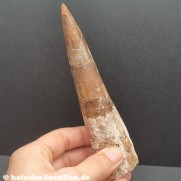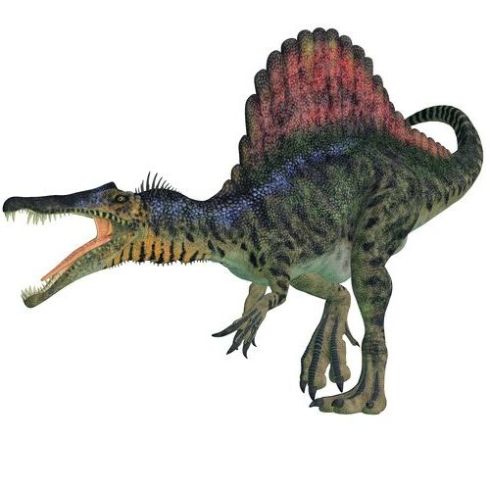-
Warenkorb ist noch leer.
MENÜ

 Das besondere Merkmal des Spinosaurus sind die auffälligen Dornfortsätze der Rückenwirbel, die mindestens 1,7 Meter lang wurden und wahrscheinlich mit Haut zu einer segelartigen Struktur verbunden waren. Einige Wissenschaftler vermuten, dass die Fortsätze von Muskeln umgeben waren und einen langgezogenen Höcker bildeten. Die Funktion dieses Segels ist noch unklar. Es könnte sich um eine Struktur zur Thermoregulation oder Kommunikation mit Artgenossen (z.B. Imponier-verhalten) handeln. Die Schnauze des Spinosaurus fiel schmal aus und war mit ungezahnten konischen Zähnen ausgestattet. Am Vorderende des Oberkiefers befanden sich pro Seite sechs bis sieben Zähne. Auf der Hinterseite waren jeweils weitere zwölf Zähne angebracht. Die Zähne des Spinosaurus sind gerade und spitz zulaufend.
Das besondere Merkmal des Spinosaurus sind die auffälligen Dornfortsätze der Rückenwirbel, die mindestens 1,7 Meter lang wurden und wahrscheinlich mit Haut zu einer segelartigen Struktur verbunden waren. Einige Wissenschaftler vermuten, dass die Fortsätze von Muskeln umgeben waren und einen langgezogenen Höcker bildeten. Die Funktion dieses Segels ist noch unklar. Es könnte sich um eine Struktur zur Thermoregulation oder Kommunikation mit Artgenossen (z.B. Imponier-verhalten) handeln. Die Schnauze des Spinosaurus fiel schmal aus und war mit ungezahnten konischen Zähnen ausgestattet. Am Vorderende des Oberkiefers befanden sich pro Seite sechs bis sieben Zähne. Auf der Hinterseite waren jeweils weitere zwölf Zähne angebracht. Die Zähne des Spinosaurus sind gerade und spitz zulaufend. 10,1 cm schmaler Zahn des Spinosaurus Der 10,1 cm große und schmale Zahn des Spinosaurus aegyptia..
199,00€ Netto 167,23€
11,5 cm schöner Zahn des Spinosaurus aegyptiacus Der 11,5 cm große Zahn des Spinosaurus aegyptiac..
199,00€ Netto 167,23€
12,5 cm massiver Zahn des Spinosaurus Der 12,5 cm große Zahn des Spinosaurus aegyptiacus ist sehr..
289,00€ Netto 242,86€
12,6 cm langer gebogener Zahn des Spinosaurus Der 12,6 cm lange Zahn des Spinosaurus aegyptiacus bes..
279,00€ Netto 234,45€
13,6 cm langer massiver Zahn des Spinosaurus Der 13,6 cm lange Zahn des Spinosaurus aegyptiacus bee..
357,00€ Netto 300,00€
2,1 cm brauner Zahn des Spinosaurus Der 2,1 cm kleine Zahn des Spinosaurus aegyptiacus ist facett..
22,00€ Netto 18,49€
2,2 cm heller Zahn des Spinosaurus Der 2,2 cm kleine Zahn des Spinosaurus aegyptiacus besitzt ein..
22,00€ Netto 18,49€
2,5 cm heller Zahn des Spinosaurus Der 2,5 cm große Zahn des Spinosaurus aegyptiacus besitzt eine..
22,00€ Netto 18,49€
2,6 cm heller Zahn des Spinosaurus Der 2,6 cm lange Zahn des Spinosaurus aegytiacus besitzt einen he..
29,00€ Netto 24,37€
2,8 cm Zahn des Spinosaurus Der 2,8 cm kleine Zahn des Spinosaurus aegyptiacus besitzt einen rotb..
27,00€ Netto 22,69€
3,1 cm dunkler Zahn des Spinosaurus Der 3,1 cm dunkle Zahn des Spinosaurus aegyptiacus besitzt ei..
29,00€ Netto 24,37€
3,6 cm brauner Zahn des Spinosaurus The 3.6 cm long tooth of Spinosaurus aegyptiacus has a beautifu..
29,00€ Netto 24,37€
3,6 cm bunt gemusterter Zahn des Spinosaurus Der 3,6 cm lange Zahn des Spinosaurus aegyptiacus besi..
29,00€ Netto 24,37€
3,6 cm rotbrauner Zahn des Spinosaurus Der 3,6 cm kleine Zahn des Spinosaurus aegyptiacus besitzt ..
29,00€ Netto 24,37€
3,6 cm schön gefärbter Zahn des Spinosaurus Der 3,6 cm lange Zahn des Spinosaurus aegyptiacus besit..
29,00€ Netto 24,37€
3,7 cm gemusterter Zahn des Spinosaurus Der 3,7 cm lange Zahn des Spinosaurus aegyptiacus besitzt ei..
29,00€ Netto 24,37€
3,8 cm dunkler brauner Zahn des Spinosaurus Der 3,8 cm große Zahn des Spinosuarus aegyptiacusbesit..
29,00€ Netto 24,37€
3,9 cm brauner Zahn des Spinosaurus Der 3,9 cm lange Zahn des Spinosaurus aegyptiacus besitztz ein..
29,00€ Netto 24,37€
3,9 cm breiter Zahn des Spinosaurus Der 3,9 cm große Zahn des Spinosaurus aegyptiacus besitzt eine..
32,00€ Netto 26,89€
3,9 cm hellbrauner Zahn des Spinosaurus Der 3,9 cm lange hellbraune Zahn des Spinosaurus aegyptiacu..
34,00€ Netto 28,57€